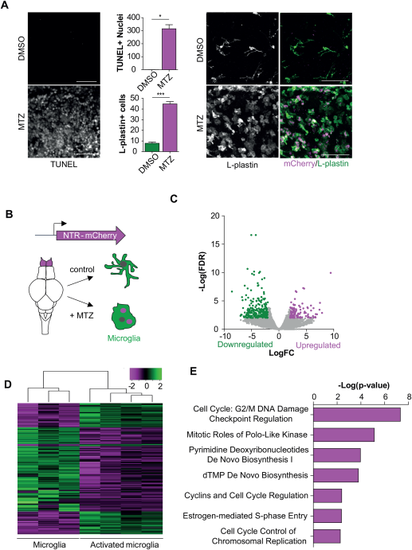- Title
-
Identification of a conserved and acute neurodegeneration-specific microglial transcriptome in the zebrafish
- Authors
- Oosterhof, N., Holtman, I.R., Kuil, L.E., van der Linde, H.C., Boddeke, E.W., Eggen, B.J., van Ham, T.J.
- Source
- Full text @ Glia
|
Identification of gene expression changes upon neuronal cell death. (A) TUNEL and L-plastin staining showing increased neuronal cell death upon treatment with MTZ for 48 hours accompanied by microglia activation. mCherry signal represents engulfed neurons. (B) Schematic representation of cells isolated for RNA sequencing on activated microglia. (C) Volcano plot showing differentially expressed genes upon the activation of microglia (FDR <0.01; LogFC?>?|2|). (D) Heatmap showing Z-score values of all genes differentially expressed between activated microglia and control microglia (367 genes) (FDR <0.01, LogFC?>?|2|).(E) IPA canonical pathway analysis on significantly upregulated genes in microglia upon NTR-mediated ablation (FDR <0.01;LogFC?>?|2|). Scale bar?=?40 µm in (A). For quantification in (A) cells were counted in 3 selected volumes in the olfactory bulb (4.0 × 10 ? 4 mm3) per fish (n?=?3). Error bars represent standard deviation, *P?<?0.05, ***P?<?0.001 (Student's t-test). |
|
Microglia proliferation upon the induction of neuronal cell death. (A) Immunofluorescence staining in the olfactory bulbs of 3-month-old treated MTZ-treated and DMSO-treated (control) fish. (B) Intravital imaging in 7 dpf zebrafish larvae with Apoe-driven GFP undergoing NTR-mediated neuronal cell death, showing the presence of dividing zebrafish microglia upon neuronal death. n?=?3. Scale bar?=?40 µm in (A). For quantification in (A) cells were counted in 3 selected volumes in the olfactory bulb (4.0 × 10 ? 4 mm3) per fish (n?=?3). Error bars represent standard deviation, *P?<?0.05 (Student's t-test). |


